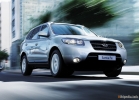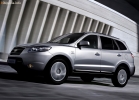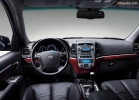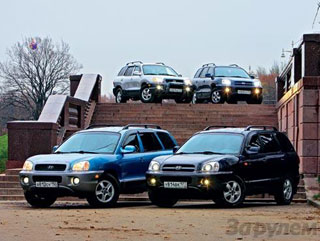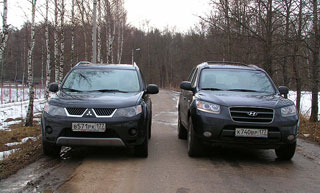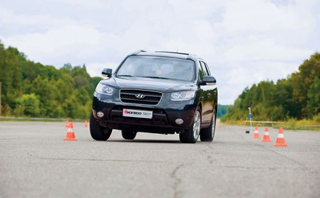Hyundai Santa Fe 2006 test drive - 2009 SUV
Dreaming is not harmful
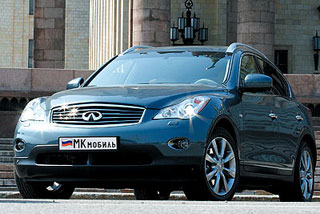 Being the owner of the Korean car in Russia has long been a sign of poverty or, say, bad tone
Being the owner of the Korean car in Russia has long been a sign of poverty or, say, bad tone Cars from the country of morning freshness in recent years have proved that they have an excellent price/quality ratio, and they are all right with reliability.
No wonder in different ratings Korean cars are increasingly occupying high places. Today's guest of the first -generation Hyundai Santa Fe section, which, incidentally, is still leaving the assembly line. True, not in Korea, but in Russia at the Tagaz factory under the name Santa Fe Classic.
Santa Fe does not have some outstanding abilities. Yes, in fact, no one requires it from him, because in most cases only one is needed from the Korean car to drive. The appearance of Santa Fe is no longer the most modern, but the model looks quite harmonious on the road. The cabin, of course, is hard and not the most expensive plastic, although there are no special complaints about the design. The equipment of the machine is different. There are simple cars (however, the condition and electric drives glass-mirror will be there), but American crossovers often already have a leather interior. The skin, of course, is pleasant, but such cars must be carefully inspected. Koreans sheathed their salons not by the most expensive skin, which after 57 years was erased and does not look. But the Santa Fe electrician usually works without complaints. True, on some cars the heating of the mirrors broke.
Sometimes you hear about the dubious corrosion resistance of the body. But the 8-year-old experience of Santa Fe has shown that there is nothing to be afraid of here. If the car has not been in accidents, then it does not rust.
Under the hood of Hyundai Santa Fe, a variety of engines can stand. The base engine is a gasoline 2-liter unit issuing 136 hp. Such cars were sold mainly only in Korea, with front -wheel drive. In the secondary market, the price of 2-liter Santa Fe, of course, is the lowest, but there is no sense in buying such a car. It has very modest dynamic capabilities, and the presence of a drive only on one axis does not add advantages to the budget Santa Fe. There are other disadvantages. For example, the masters say that the 2-liter engine wears out faster than others, because drivers are forced to constantly promote it, and after a run of 150,000 km, the engine may require repairs.
However, there are few 2-liter Santa Fe Fe in our secondary market. And buyers most often choose between cars with gasoline engines: a 4-cylinder volume of 2.4 liters or V6 with a volume of 2.7 liters, outstanding 145150 and 170173 hp. respectively. These power units are already great for the Korean crossover.
Cars equipped with them have a power supply and torque necessary for a comfortable driving, and the all -wheel drive system is present here without fail.
There are also diesel Santa Fe, which, incidentally, are not so rare. Under the hood of such machines, a 2.0 liter motor is hidden. Most often, he gives out 112 hp, but in recent years, the Koreans put on their crossover and the 125-horsepower version of the unit. 112 horses, of course, are not enough for Santa Fe. For example, the acceleration time to 100 km/h at a machine with such an engine and an automatic gearbox occupies endless 17 s (and this is according to passport data). But the 125-horsepower Santa Fe looks very worthy if you meet such a car in good condition on the market, you can safely buy.
Brought from the USA and Santa Fe with a 3.5-liter engine that issues 200 hp. The last model is good for everyone, but
Do not forget that Santa Fe is still an inexpensive car that must be bought not based on the concept of cool not cool, but focusing on the price/quality ratio. Do not also forget about the cost of operation and fuel consumption. In addition, due to the features of our customs clearance, the Santa Fe 3.5 is painfully expensive (for a 3.5-liter engine, the customs will ask $ 12,000 versus $ 7300 per SUV with a 2.4-liter engine).
Masters assure that all gasoline engines are reliable. However, this does not mean that the driver of Santa Fe may not serve them. After all, Korean motors require very careful care. For example, all Santa Fe owners should remember that the timing belt here is strongly recommended to change every 60,000 km, and not after 100,000120,000 km, as many are used to doing in European or Japanese cars. It costs about $ 400,500, taking into account spare parts. Moreover, it is better to perform work on the company service: replacing the timing belt has a number of features. And if the belt breaks, then the overhaul of the engine will surely require. The spark plugs are not too tenacious here, which, because of our gasoline, sometimes die every 15,000 km. And their replacement will cost $ 120150 (for the V6 engine). Agree, a lot.
Before buying a car, do not forget to check the condition of the oil, especially for Santa Fe from the United States, where many drivers simply do not understand why every 15,000 km to update the lubricant if the car drives so well (by the way, then you need to do 7500 km on a diesel engine ). The 2.4-liter gasoline engine is especially sensitive to the clock. Therefore, servicemen are advised after buying a used Santa Fe (regardless of the volume of the motor) to change oil at first often than prescribed by the instructions. So to speak, for the natural cleaning of the engine.
Surprisingly, the claims of the mechanics to the transmission mainly concerned the mechanical gearbox, more precisely, the clutch. It sometimes broke after 20,000 km. But here you need to make one very important amendment: you will almost never find cars with an unsuccessful clutch design on the secondary market: defective parts produced before 2003 have already been replaced. However, if the car has passed about 120,000 km, then be morally prepared for the fact that the clutch on the mechanics will still have to be changed (about $ 400 with work).
When buying a car with automatic transmission, you also need to be careful. The machine is considered reliable, but not eternal. Therefore, with a run of 150,000 km, especially if earlier the driver traveled aggressively or crawled out onto the road, it may be necessary for a non -cheap repair of the box. And here it is worth thinking: maybe it is more profitable to bring a restored box from North America. In addition, remember that in the automatic transmission you need to change oil without fail according to the recommendations of the manufacturer.
The Hyundai Santa Fe has a constant all -wheel drive system with a distribution of torque in a ratio of 60/40 in favor of the front axle (as a result, the machine behaves like a front -wheel drive on the highway). At the same time, there is an interdose differential, which, however, is not blocked mechanically, but only after the start of slipping. Moreover, on some machines you can find the rear interventor differential of high friction, which was set for surcharge. For a crossover, in fact, a rather decent equipment. As for the reliability of an all -wheel drive transmission, the masters cannot say anything bad about it. Just remember that Santa Fe is not designed to conquer off -road. And if you ride it for a long time through the mud, then you can overheat the viscousoft. The destiny of this car is a city.
The independent Santa Fe suspension in front and behind allows the car to feel good on the asphalt. In addition, this Korean has worthy smoothness, which is very pleasant. Reliability of the chassis at the average -based level. That is, about 100,000130,000 km, it should leave, and then you will have to change shock absorbers, levers, hub bearings and so on. But if you take a machine with a mileage of 50,000 km, then on the service, in theory, only the bushings of the front and rear stabilizers can change.
Most of the used Santa Fe from the USA or Canada. The Americans have a profitable acquisition, because they initially cost a little, and besides, Koreans are getting cheaper than Germans or Japanese over the years.
Crossovers are brought from Korea, and very affordable options with a 2-liter gasoline engine and front-wheel drive come across. But cars sold originally in Russia are usually the most expensive. But the masters say that it is with such Santa Fe that the least problems.
EXCURSION
Santa Fe was for Hyundai the first crossover in the history of the company. Moreover, this was generally the first all -wheel drive car created by the engineers of the Korean company independently (the Hyundai Galloper produced before was only a modernized Mitsubishi Pajero model of the 19811991).
The Santa Fe concept was first shown to the public in 1999, and in 2000 the production of a car began. At first, Santa Fe had only two gasoline engines with a volume of 2.0 and 2.7 liters. Moreover, the first engine was put only on the version with the front-wheel drive, and the cars with a 2.7-liter V6 had an all-wheel drive transmission. Later, the range of power units expanded with a 2.4 liter gasoline engine and a 2.0-liter diesel engine. The latter appeared in 2001. And in 2003, Santa Fe sold in the USA began to put an engine with a volume of 3.5 liters. In 2004, the Santa Fe restyling was carried out. The car received small changes both in appearance and in the salon.
Well, in 2006, the production of the second generation of Santa Fe began. Now this car is equipped with a 2.7 liter gasoline engine (189 hp) and a 2.2-liter diesel engine (150 hp). Also in 2006, it was decided that the old Santians would collect Tagaz in Russia called Santa Fe Classic. We are now making classics with a diesel 2-liter engine and with a 2.7 liter V6 (while diesel machines can be front-wheel drive).
Hyundai Santa Fe is a very worthy car that, even in a used state, will not disappoint the owner. The machine has a good price/quality ratio, but it has disadvantages. For example, Korean cars fall in price faster than Japanese, and spare parts are very decent. Especially on the company service (by the way, some owners complain about this very service).
FITTING
The 2004 Hyundai Santa Fe was bought initially in Russia from an official dealer. The crossover attracted primarily an acceptable price and good equipment. In addition, according to the seller, several of his acquaintances at that time already owned Santa Fe and no one had any complaints about the car.
Santa Fe did not disappoint. A car with a 2.7 -liter gasoline engine never broke, demanding only every 15,000 km of a visit to a service station. The only thing that I did not like was delays when switching the machine and poor sound insulation.
To date, the car mileage is 70,000 km. This is not so much for a foreign SUV with decent quality assembly quality. However, the owner decided to sell Santa Fe for 530,000 rubles and take something more prestigious (his choice fell on one Japanese crossover).
General Director of the Center for Car loans, Ph.D. Dmitry Erokhin
Comparing credit programs for the purchase of Hyundai Santa Fe 2002 and 2005, we can say that almost all banks worsen the terms of lending with increasing the age of the car. Changes in lending conditions relate to several parameters of car loan.
Firstly, this is a restriction on the maximum age of the car. As a rule, such age -related restrictions are attached to the loan term. For example, a loan will be given only two years for the 2001 car, the maximum loan term for buying a 2002 car was released for three years, etc. And as we know, the reduction in the loan period directly affects the amount of the monthly payment.
Secondly, banks increase the requirements for the size of the initial payment. So, for the 2005 Hyundai Santa Fe, the size of the initial payment on average for banks varies in the range from 0 to 10% of the price of the car, and when buying the Hyundai Santa FE of 2002, in some banks, the initial contribution is increased to 20%. Thirdly, with an increase in the age of the car, the interest rates on the loan and insurance are changed. A rule has already been formed on the market, which is the older the car, the higher the loan rates. Also, with an increase in the age of the car, CASCO insurance rates are growing, and the 2002 Hyundai Santa Fe insurance can be more than 15% of the price of the car. Which also does not make a particularly attractive purchase of a 67-year-old car on credit. Although, maybe this is right that banks worsen the terms of lending and thereby pushing buyers to buy more fresh cars. After all, financial structures are interested in that a person drive a car and pay a loan, and not constantly engage in its repair. The accumulated statistics on used cars in banks are enough to conclude: the older the car, the higher the probability of its breakdown.
Denis Smolyanov
Photo author: Alexander Polunin
A source: Mkobil magazine [September/2008]
Hyundai Santa Fe 2006 Krash Video - 2009
Hyundai Santa Fe 2006 test drives - 2009
Hyundai Santa Fe 2006 Krash Test - 2009
Krassh Test: Detailed Information29%
Driver and passengers
36%
Children-passengers


